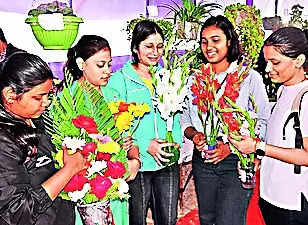Patna: Deputy chief minister-cum-agriculture minister Vijay Kumar Sinha on Friday inaugurated a three-day ‘Bagwani Mahotsav’ at Gandhi Maidan in the state capital here.
The Mahotsav, organised by the horticulture directorate of the state’s agriculture department, showcases the progressive steps taken by the state govt toward the development of horticulture in different districts.The Mahotsav will conclude on February 18. Speaking on the occasion, the deputy CM said he was confident that cultivators from across the state would benefit from the state govt’s agriculture-related schemes and would positively contribute towards the state’s overall development.
Sinha also released a book on cultivation practices of vegetables, fruits, medicinal and aromatic plants, etc. A horticulture produce-based calendar was also released on the occasion. The beneficiaries under different schemes were handed over the subsidy cheques and work orders at the ‘Mahotsav’.
Altogether 50 stalls about horticulture and related aspects have been put up in the event. Stalls from prominent institutions from across India such as the Central Institute for Sub-Tropical Horticulture-Lucknow, and Indian Institute for Horticulture Research-Bangalore, have also been exhibited at the event.
Several governmental institutions like Dr Rajendra Prasad Central Agricultural University-Pusa, the Bihar Agricultural University-Bhagalpur and the National Cooperative Development Corporation have also participated in the ‘Mahotsav’. A total of 7,376 exhibits have been put up in the ‘Bagwani Mahotsav’ by 738 farmers/gardeners/flower enthusiasts from different districts of Bihar.
The agriculture secretary Sanjay Kumar Agarwal said, through this ‘Mahotsav’, the state govt aims to encourage farmers and entrepreneurs (related to fruits, flowers, vegetables and other horticultural produce) of Bihar towards quality produce and to promote innovative dimensions in the field of horticulture.
The Mahotsav, organised by the horticulture directorate of the state’s agriculture department, showcases the progressive steps taken by the state govt toward the development of horticulture in different districts.The Mahotsav will conclude on February 18. Speaking on the occasion, the deputy CM said he was confident that cultivators from across the state would benefit from the state govt’s agriculture-related schemes and would positively contribute towards the state’s overall development.
Sinha also released a book on cultivation practices of vegetables, fruits, medicinal and aromatic plants, etc. A horticulture produce-based calendar was also released on the occasion. The beneficiaries under different schemes were handed over the subsidy cheques and work orders at the ‘Mahotsav’.
Altogether 50 stalls about horticulture and related aspects have been put up in the event. Stalls from prominent institutions from across India such as the Central Institute for Sub-Tropical Horticulture-Lucknow, and Indian Institute for Horticulture Research-Bangalore, have also been exhibited at the event.
Several governmental institutions like Dr Rajendra Prasad Central Agricultural University-Pusa, the Bihar Agricultural University-Bhagalpur and the National Cooperative Development Corporation have also participated in the ‘Mahotsav’. A total of 7,376 exhibits have been put up in the ‘Bagwani Mahotsav’ by 738 farmers/gardeners/flower enthusiasts from different districts of Bihar.
The agriculture secretary Sanjay Kumar Agarwal said, through this ‘Mahotsav’, the state govt aims to encourage farmers and entrepreneurs (related to fruits, flowers, vegetables and other horticultural produce) of Bihar towards quality produce and to promote innovative dimensions in the field of horticulture.
We also published the following articles recently
In 3 decades, cash, horticulture crops replace pulses, cereals in Gujarat: Study
A study in Gujarat revealed a decline in cereals and oilseed sowing, while commercial and horticultural crops saw significant rise. Factors influencing the change in crop pattern include water availability, market trends, minimum support price, agricultural innovations, and Narmada water. Regions like Kutch and North Gujarat showed further changes in sowing and crop pattern.
A study in Gujarat revealed a decline in cereals and oilseed sowing, while commercial and horticultural crops saw significant rise. Factors influencing the change in crop pattern include water availability, market trends, minimum support price, agricultural innovations, and Narmada water. Regions like Kutch and North Gujarat showed further changes in sowing and crop pattern.
